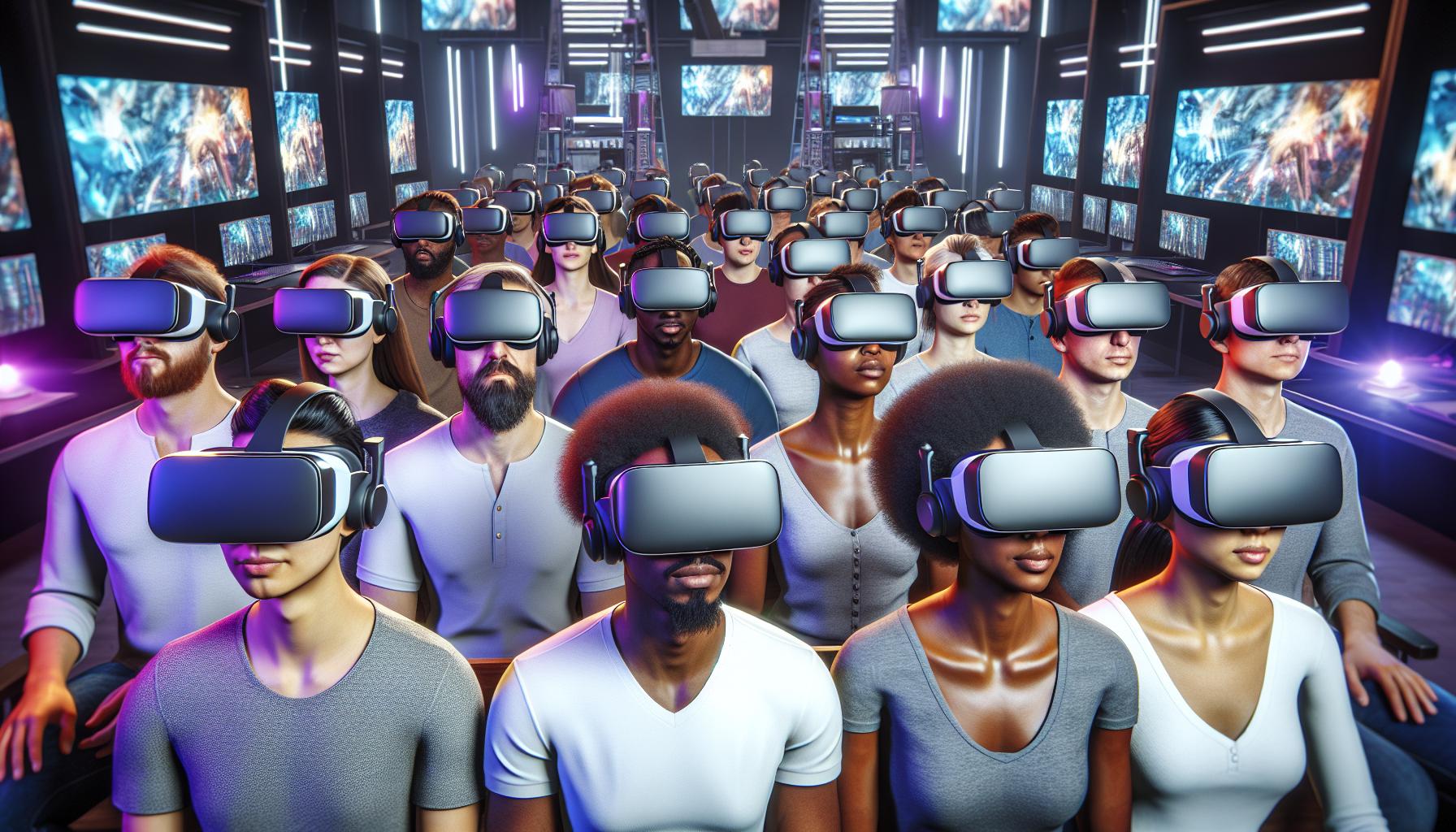Key Takeaways
- Diverse Applications: Virtual reality technology is transforming various sectors, including gaming, education, healthcare, and training, enhancing user engagement and interactivity.
- Key Players: Notable companies like Oculus, HTC Vive, Sony, Valve, Niantic, Unity, and Epic Games are leading innovation in VR, each offering unique hardware and software solutions.
- Technological Advancements: Hardware innovations such as high-resolution headsets and motion-tracking controllers, alongside powerful game engines like Unity and Unreal Engine, drive engaging VR experiences.
- Emerging Trends: Future VR advancements will be influenced by AI integration, 5G connectivity, mixed reality, eye tracking, and improved haptic feedback, enhancing user interaction and immersion.
- Market Growth Potential: The VR market is projected to expand significantly, with an estimated size reaching $57.55 billion by 2030, driven by increased adoption across various sectors beyond gaming.
Virtual reality has transformed the way we experience digital content, making it an exciting frontier for innovation. Companies in this space are pushing boundaries, creating immersive environments that blur the lines between reality and the virtual world. From gaming to education and healthcare, the applications of VR technology are vast and varied, capturing the imagination of consumers and businesses alike.
As the industry grows, a diverse range of companies are emerging, each contributing unique solutions and experiences. These virtual reality pioneers are not just enhancing entertainment; they’re redefining how people interact with technology. With advancements in hardware and software, the future of virtual reality looks brighter than ever, promising to reshape industries and everyday life.
Virtual Reality Companies
Virtual reality companies drive innovation in immersive experiences across multiple sectors. These companies develop hardware and software solutions that enhance engagement and interactivity in gaming, education, healthcare, and training. Here are several notable players in the virtual reality landscape:
- Oculus: A subsidiary of Meta, Oculus specializes in VR headsets like the Oculus Quest. Its technology focuses on delivering high-quality gaming and social interactions within virtual environments.
- HTC Vive: HTC offers the Vive line of headsets, targeting consumers and businesses. Vive’s technology supports room-scale tracking, providing users with substantial freedom of movement in virtual spaces.
- Sony Interactive Entertainment: Known for its PlayStation VR headset, Sony merges gaming with VR technology. Its immersive gaming experiences have attracted a significant audience within the gaming community.
- Valve Corporation: Valve develops the Valve Index, a high-end VR headset recognized for its visuals and precision. Valve’s commitment to game development also enhances its VR ecosystem.
- Niantic: The company behind Pokémon GO, Niantic focuses on augmented reality but incorporates VR elements. Its innovations promote outdoor exploration, integrating physical and virtual play.
- Unity Technologies: Unity offers a real-time development platform for creating VR content. Its user-friendly interface enables developers to craft immersive experiences efficiently.
- Epic Games: Known for Unreal Engine, Epic provides powerful tools for VR development. Its engine delivers visually stunning experiences across different industries, particularly gaming and entertainment.
Virtual reality companies continue to push the boundaries of technology and creativity. With emerging innovations, these companies forge new paths for immersive experiences that reshape how people interact with digital content.
Notable Virtual Reality Companies

Several companies play crucial roles in advancing virtual reality technology, each contributing to the industry’s growth through unique innovations and approaches.
Company A: Pioneering Innovations
Oculus, a subsidiary of Meta Platforms, Inc., leads the way in VR innovations. Oculus Rift and Quest headsets provide users with immersive experiences. Their focus on accessibility, affordability, and compelling content accelerates adoption in gaming and social interaction.
Company B: Market Disruptors
HTC Vive has redefined the VR landscape with its Vive series. The company emphasizes room-scale VR experiences that enhance interactivity. Collaboration with various software developers expands the Vive ecosystem, making it a powerful platform for both entertainment and enterprise solutions.
Company C: Focus on Gaming
Sony Interactive Entertainment revolutionizes gaming through its PlayStation VR. Offering exclusive titles and seamless integration with the PlayStation console, the platform enhances the immersive gaming experience. Their commitment to high-quality content propels gaming forward in the VR market.
Technologies Used by Virtual Reality Companies

Virtual reality companies leverage advanced technologies to create immersive experiences. These technologies primarily encompass hardware innovations and software development tailored for VR applications.
Hardware Innovations
Hardware innovations form the backbone of virtual reality experiences. Key components that enhance VR include:
- Headsets: Companies like Oculus and HTC Vive produce headsets with high-resolution displays and advanced tracking systems. These headsets provide users with a visual experience that mimics real-life settings.
- Controllers: Motion-tracking controllers from companies like Valve and Sony enhance interaction by allowing users to manipulate virtual environments intuitively.
- Sensors: External sensors and cameras help track user movement, improving immersion. Systems such as the HTC Vive base stations exemplify this technology.
- Haptic Feedback Devices: Wearable haptic feedback devices allow users to feel virtual interactions, adding realism to experiences. Companies like B Haptics specialize in this area.
Software Development
Software development drives the creation of engaging VR content. Essential aspects include:
- Game Engines: Unity and Unreal Engine dominate VR game development, offering tools that streamline asset creation and scene design. Their robust ecosystems support both high and low-end hardware.
- Applications: VR software encompasses gaming, training simulations, and educational programs. Companies such as Niantic use augmented reality to combine virtual elements with real-world environments, enhancing user engagement.
- Development Kits: SDKs from major VR companies provide developers with resources to create applications across platforms. These kits streamline the integration of hardware capabilities with software functions.
- Artificial Intelligence: AI enhances user experiences by enabling dynamic interactions and personalized content. Advanced algorithms analyze user behavior, making VR environments more reactive and immersive.
By integrating cutting-edge hardware and software solutions, virtual reality companies ensure that users experience the next level of digital interactivity.
Future Trends in Virtual Reality Companies

The future of virtual reality (VR) companies hinges on the integration of emerging technologies and expanding market opportunities. Innovations in VR will significantly shape user experiences and industry dynamics.
Emerging Technologies
Emerging technologies play a pivotal role in advancing virtual reality. Key trends include:
- AI Integration: Artificial intelligence enhances personalization and responsiveness in VR experiences, enabling adaptive storytelling and improved user interactions.
- 5G Connectivity: High-speed 5G networks facilitate seamless streaming and reduce latency, allowing for more dynamic and interactive VR applications.
- Mixed Reality (MR): Combining VR with augmented reality (AR) creates blended environments that enhance user engagement across diverse sectors such as education and training.
- Eye Tracking: This technology allows for more intuitive control and a more immersive experience by responding to user gaze, facilitating better interaction within environments.
- Haptic Feedback: Advanced haptic devices improve immersion, providing tactile sensations that mirror real-world interactions, enhancing the realism of virtual environments.
Potential Market Growth
The potential for market growth in virtual reality remains substantial. Current projections suggest:
| Year | Estimated Market Size (in Billion USD) |
|---|---|
| 2023 | 15.81 |
| 2025 | 22.86 |
| 2030 | 57.55 |
With applications expanding beyond gaming into sectors like healthcare, real estate, and remote work, increased investment and consumer adoption drive this growth. Companies focusing on innovative solutions and partnerships have the opportunity to capture significant market shares in the evolving landscape of virtual reality.
The Landscape Of Virtual Reality
The landscape of virtual reality is rapidly evolving thanks to the innovative efforts of leading companies. As they push the boundaries of technology and creativity, immersive experiences are becoming more accessible and engaging. The potential applications for VR continue to expand beyond entertainment into vital sectors like education and healthcare.
With advancements in hardware and software, the future of virtual reality looks bright. Emerging technologies promise to enhance user interaction and redefine how individuals engage with digital content. As the market grows, these developments will undoubtedly shape the way people experience both virtual and real worlds.